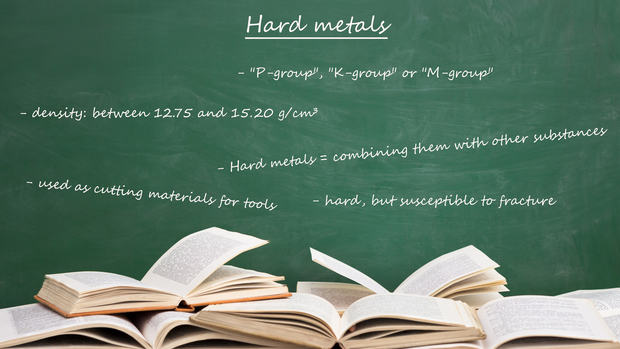Properties of Hard metals
Hard metals are composite materials that do not exist in a pure form.
Hard metals are only created when they are mixed with other substances.
They are alloys of metallic hard materials and binding material, mostly in the form of cobalt or nickel.
Hard metals are not "real" metals, but carbides that are bound by the metal.Based on their composition,
hard metals can be divided into three groups. "P-group", "K-group" or "M-group" are distinctions in hard metals.
These groups are designated with numbers. The number describes the wear behaviour and the toughness.
If the wear resistance is greater, the Hard metal is still marked with a smaller number.
Another way of dividing them would be into tungsten carbide-cobalt hard materials,
Hard metal grades for steel machining and cermets. Cermets are a mixture of ceramic and metal.
Cermets are less hard than pure hard materials, but they are tougher. In contrast to hardened steel or other alloys,
they are comparatively harder, but also more susceptible to fracture. The density of hard metals is between 12.75 and 15.20 g/cm³.
By comparison, other steels have a density of 7.85 g/cm3. Because this material can be processed up to 900°,
it has a high temperature resistance. It is therefore characterised by a high thermal hardness.
Hard metals are created by combining them with other substances such as cobalt or nickel. In their original state, they are present in small particles and are then held together by a matrix of metal. The production takes place in a multi-stage process. At the beginning, the particles are mixed, ground and then and then manufactured into granules.
Under pressure, the processing of the powder of the components takes place. This is done until it becomes granulate and takes on its shape.
It is further processed during sintering. Next comes the finishing and the subsequent coating. Hard metals are predominantly used as cutting materials for tools in machining operations. This includes turning,
milling or drilling. Another area of application is in wear-resistant dies, such as in forming or punching tools. This is because the material has a high hardness and wear resistance. The result is that the service life of the components and the tools is significantly increased.
Do you want to have a milled or turned part made of aluminium or stainless steel?
Or are you interested in having your desired component milled or drilled with the help of contract manufacturing?
Submit your enquiry quickly and easily and we will get back to you with a quote in line with the market.
We look forward to hearing from you.


